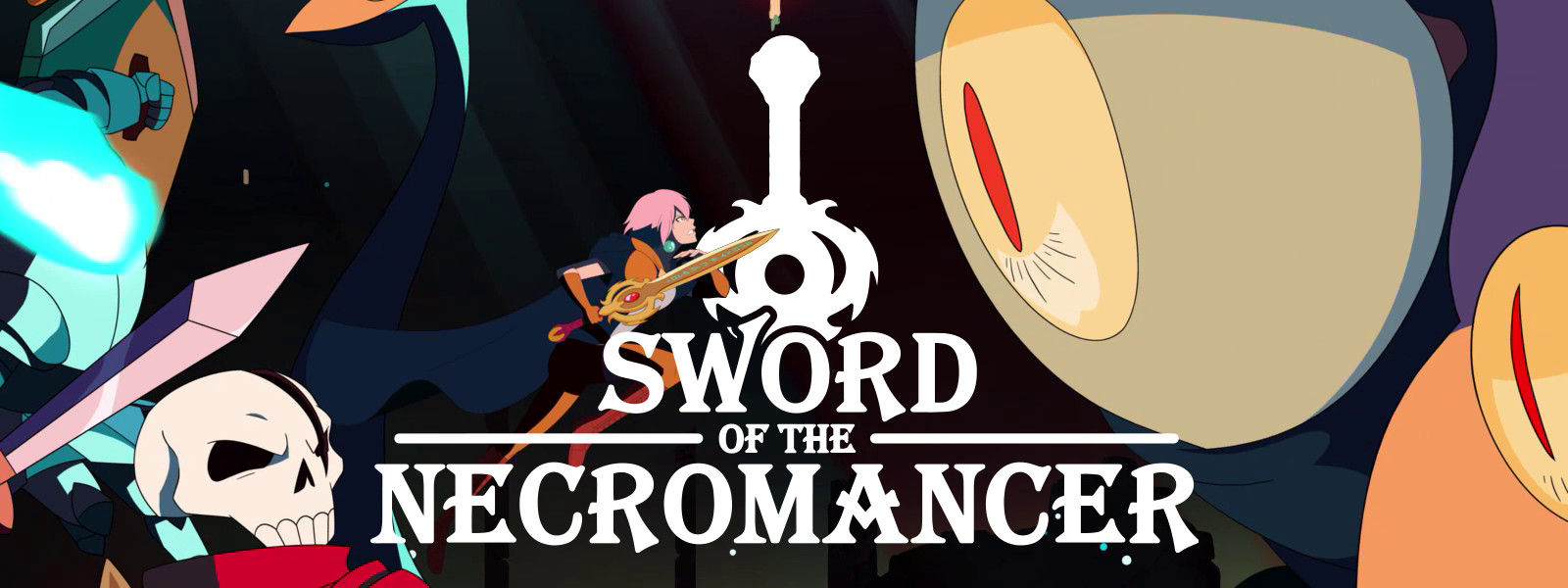Kickstarted around April 2020, I was a backer for this game. I backed it because it promised a fun rogue-lite experience and a queer plot. What isn’t there to enjoy? I ended up playing the Switch version on my stream one morning after receiving my key in March of 2021. This game is exemplary. Sadly, it is exemplary of so many negative things. Let’s get into this. While I will avoid getting into too much of the details, there will be some spoilers ahead.
Help Tama to save Koko using the powers of the forbidden Sword of the Necromancer. Turn your foes into allies and reach the depths of the Necromancer’s dungeon. Defeat the guardians to gain enough soul power to bring Koko back from the dead, no matter the cost.
Gameplay 
Tama can do very few actions, simplifying the controls to move, dash or use an item. The latter two can prove to be problematic. Among the various stats you have, the most important aside from your health is Soul. Soul can be spent to use certain actions. Which actions? Well dashing of course. But also all other actions. Every action. Each one uses Soul. Dash, use a charged attack, summon a monster, and cast a spell. They all use Soul! And do you have very much of it? Nope. Dashing out of combos is something the game itself recommends to you. So it is used in regular attacks as well. It can make certain builds very problematic. The spellbook weapons for example are particularly bad as they always use Soul to attack.
I mentioned using items. In Necromancer you have four item slots, mapped to the face buttons, to help you get through the dungeons. The Sword? Of the Necromancer? Oh yeah, that takes up permanent residence on one of your slots. So you have three item slots. But with the titular sword, you can resurrect dead monsters to help you fight your way to victory. Those monsters? They also take up a slot. So do any weapons you find, restorative items, and any other equipment you are carrying. You can see how quickly juggling your inventory becomes tedious.
With such a small inventory, quality over quantity is vital. And so the game does offer the ability to customize your weapons via forging. You just bring the item, along with the required materials, out to the hub area and make yourself a new fancy weapon. How does one get to the hub? Well, you go there when you die. But you also lose all your items. You could exit between bosses. Or use an item (that takes up yet another slot) to exit safely. Then you can forge a weapon that will disappear should you happen to die. Very efficient.
All this being said the formula of Necrodancer is just that—a formula. You go in, clear a floor, find a key, fight the boss. Rinse and repeat. Standard fare for Rogue-likes. And yet it barely manages that.
Story 
I told myself I would not rate anything 0 Stars. And I almost broke that rule with the first review of this series. Sword of the Necrodancer features a classic story—a bodyguard falls for their charge. The twist is the sapphic angle of this story. Do you know what isn’t a twist? Queer tragedy. Queer stories where relationships never bear fruit because of trauma are the norm. It isn’t cute, it isn’t the representation we need. It’s trite and old.
This is where I have to point something out. The staff of Necromancer consists of masculine-presenting individuals. Knowing this, what can be seen as a cute coming-out tale of two young women falling in love is tainted. So many of the scenes and conversations have stereotypical male-gaze content. And of course, the tale ends poorly. After falling in love, Tama retrieves the eponymous sword and learns to wield it. While she does manage to resurrect Koko the pair are separated again! This time by the dark energy of the sword keeping Tama in its thrall. More queer tragedy. Not once, but twice. Is there a bad ending where one of them dies? You better believe it.
The plot isn’t original, which isn’t new for video games. But it doesn’t do anything with the tropes it was handed. It doubles down on the worst parts and struggles to stand out.
Graphics 
One thing that will always hurt a game is a lack of real visual direction. Not being able to pick a single style or method for your art, and instead, mixing styles will never end well. While I knew going into this game that the graphics were not going to be top-notch, I am still not pleased. The characters and monsters use a flat coloring style with no solid outlines. While the environments do use shading and feature dark outlines. The two different styles do not work well together. It makes it seem like some assets were recycled from a dropped project.
The visual design of the dungeon is boring. Each floor features the same art in a new palette. The room shapes are copied and pasted throughout each generated floor. And the hallways that connect them are far too long and undecorated. Even the monsters feature heavy use of palette swapping. Instead of introducing new monsters on lowers floors, we are given a new color of the same enemy. It comes off as lazy graphic design.
Sound 
The music of Necromancer is the only high point of the game. While lacking any standouts, we do have a cohesive soundtrack. Led by synth strings and ethereal melodies, it always seems fitting. Even the more light-hearted songs on the tracklist blend well with the rest of the soundtrack. My appreciation to Sinesita for her amazing work on the music front.
Most of the music is featured in the story segments of the game. When bringing these up, I have to also give a special shout-out to the amazing voice work. Morgan Berry (Tama) and Abigail Turner (Koko) do an amazing job in delivering Tama and Koko’s lines. Despite the bland writing and obvious plot direction, they made the game come alive.
Replay 
There is little to enjoy from replaying this game. If you can get over the boring and repetitive levels, there is still another hurdle. There is a forced second run to complete the plot. After clearing the game as Tama, you will have to clear the game again as Koko. Koko is described as a priestess in the plot. She is also trying to free her love from the Sword of the Necromancer itself. So this would make you think she plays differently from Tama. She does not. In fact, she is identical to Tama in gameplay. This includes being forced to carry the Sword in one of her four slots. It is round two of the exact same game. So instead of a full robust game, we get the same short bland adventure twice in a row.
Final Thoughts
Necromancer is a mash-up of too many ideas and not enough good execution. Bringing back monsters to fight for you shouldn’t limit the ability to fight for yourself. AI will always pale in comparison to doing the monster killing myself. Forging equipment for efficiency was not well thought out. Even if you turn off the rogue-like elements it isn’t satisfying and is an afterthought best left out of the game. And to be blunt: the Soul-based dashing should have been left to Hyper Light Drifter where it was done better. There I said it.
It’s pertinent to also point this out again: a huge failing of this game is the story it tells. We don’t need a team of men writing queer stories about women with no input from women. This isn’t only about this game or this dev team. Any game telling stories about minorities should include those minorities. “No stories about us, without us.”
Final Score: 
Final Status:  Beaten
Beaten


